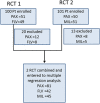Genetic variants in combination with early partial improvement as a clinical utility predictor of treatment outcome in major depressive disorder: the result of two pooled RCTs
- PMID: 25710119
- PMCID: PMC4445755
- DOI: 10.1038/tp.2015.6
Genetic variants in combination with early partial improvement as a clinical utility predictor of treatment outcome in major depressive disorder: the result of two pooled RCTs
Abstract
Pharmacogenetics may allow for a personalized treatment, but a combination with clinical variables may further enhance prediction. In particular, in the present paper, we investigated early partial improvement (EPI) defined as 20% or more improvement by rating scales 2 weeks after treatment, in combination with selected gene variants as a predictor of treatment outcome in patients with major depressive disorder. Two randomized controlled trials with 168 Japanese depressed patients were used. A stepwise multiple linear regression model with HAM-D score change at week 6 as the dependent variable and genotypes, EPI, baseline HAM-D score, age and sex as independent variables was performed in paroxetine, fluvoxamine and milnacipran, respectively, to estimate the prediction of HAM-D change at week 6. In the paroxetine sample, only EPI (P<0.001) was significantly associated with HAM-D change (n=81, R(2)=0.25, P<0.001). In the fluvoxamine sample, 5-HTTLPR La/Lg, S (P=0.029), FGF2 rs1449683C/T (P=0.013) and EPI (P=0.003) were associated with HAM-D change (n=42, R(2)=0.43, P<0.001). In the milnacipran sample, HTR-1A-1019C/G (P=0.001), ADRA2A-1297C/G (P=0.028) and EPI (P<0.001) were associated with outcome (n=45, R(2)=0.71, P<0.001). EPI in combination with genetic variants could be a useful predictor of treatment outcome and could strengthen the practical use of pharmacogenetic data in clinical practice.
Figures
Similar articles
-
The alpha 2A-adrenergic receptor gene polymorphism modifies antidepressant responses to milnacipran.J Clin Psychopharmacol. 2008 Oct;28(5):518-24. doi: 10.1097/JCP.0b013e31818455fc. J Clin Psychopharmacol. 2008. PMID: 18794646 Clinical Trial.
-
Differential period of onset of action of fluvoxamine, paroxetine and milnacipran for depression.Hum Psychopharmacol. 2003 Aug;18(6):479-82. doi: 10.1002/hup.508. Hum Psychopharmacol. 2003. PMID: 12923828
-
[Possibility of a pharmacogenetic approach for prediction and personalized medication in major depressive disorder treatment].Nihon Shinkei Seishin Yakurigaku Zasshi. 2010 Apr;30(2):83-92. Nihon Shinkei Seishin Yakurigaku Zasshi. 2010. PMID: 20491282 Review. Japanese.
-
Gender differences in the clinical effects of fluvoxamine and milnacipran in Japanese major depressive patients.Psychiatry Clin Neurosci. 2007 Aug;61(4):421-7. doi: 10.1111/j.1440-1819.2007.01679.x. Psychiatry Clin Neurosci. 2007. PMID: 17610668
-
[Prediction of antidepressant response to milnacipran and fluvoxamine using pharmacogenetical methods].Nihon Shinkei Seishin Yakurigaku Zasshi. 2010 Apr;30(2):71-6. Nihon Shinkei Seishin Yakurigaku Zasshi. 2010. PMID: 20491280 Review. Japanese.
Cited by
-
Changes in Multiple microRNA Levels with Antidepressant Treatment Are Associated with Remission and Interact with Key Pathways: A Comprehensive microRNA Analysis.Int J Mol Sci. 2023 Jul 30;24(15):12199. doi: 10.3390/ijms241512199. Int J Mol Sci. 2023. PMID: 37569574 Free PMC article.
-
Overcoming Resistance to Selective Serotonin Reuptake Inhibitors: Targeting Serotonin, Serotonin-1A Receptors and Adult Neuroplasticity.Front Neurosci. 2019 Apr 30;13:404. doi: 10.3389/fnins.2019.00404. eCollection 2019. Front Neurosci. 2019. PMID: 31114473 Free PMC article. Review.
-
Fibroblast Growth Factors in Depression.Front Pharmacol. 2019 Feb 5;10:60. doi: 10.3389/fphar.2019.00060. eCollection 2019. Front Pharmacol. 2019. PMID: 30804785 Free PMC article. Review.
-
The genetic overlap between mood disorders and cardiometabolic diseases: a systematic review of genome wide and candidate gene studies.Transl Psychiatry. 2017 Jan 24;7(1):e1007. doi: 10.1038/tp.2016.261. Transl Psychiatry. 2017. PMID: 28117839 Free PMC article.
-
Abrogated Freud-1/Cc2d1a Repression of 5-HT1A Autoreceptors Induces Fluoxetine-Resistant Anxiety/Depression-Like Behavior.J Neurosci. 2017 Dec 6;37(49):11967-11978. doi: 10.1523/JNEUROSCI.1668-17.2017. Epub 2017 Nov 3. J Neurosci. 2017. PMID: 29101244 Free PMC article.
References
-
- Rush AJ, Trivedi MH, Wisniewski SR, Nierenberg AA, Stewart JW, Warden D, et al. Acute and longer-term outcomes in depressed outpatients requiring one or several treatment steps: a STAR*D report. Am J Psychiatry. 2006;163:1905–1917. - PubMed
-
- Souery D, Oswald P, Massat I, Bailer U, Bollen J, Demyttenaere K, et al. Clinical factors associated with treatment resistance in major depressive disorder: results from a European multicenter study. J Clin Psychiatry. 2007;68:1062–1070. - PubMed
-
- Russell JM, Hawkins K, Ozminkowski RJ, Orsini L, Crown WH, Kennedy S, et al. The cost consequences of treatment-resistant depression. J Clin Psychiatry. 2004;65:341–347. - PubMed
-
- Cipriani A, Furukawa TA, Salanti G, Geddes JR, Higgins JP, Churchill R, et al. Comparative efficacy and acceptability of 12 new-generation antidepressants: a multiple-treatments meta-analysis. Lancet. 2009;373:746–758. - PubMed
-
- Kato M, Serretti A. Review and meta-analysis of antidepressant pharmacogenetic findings in major depressive disorder. Mol Psychiatry. 2010;15:473–500. - PubMed
Publication types
MeSH terms
Substances
LinkOut - more resources
Full Text Sources
Other Literature Sources
Medical
Molecular Biology Databases


